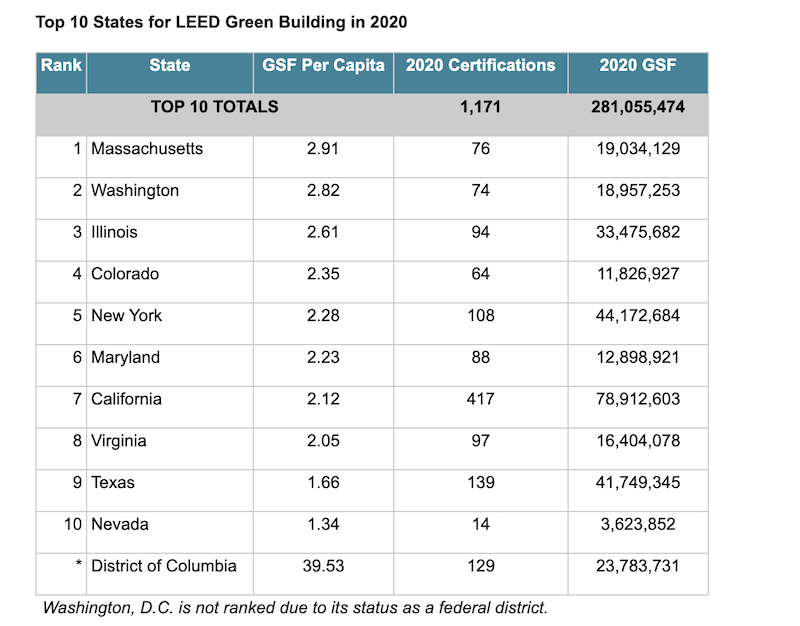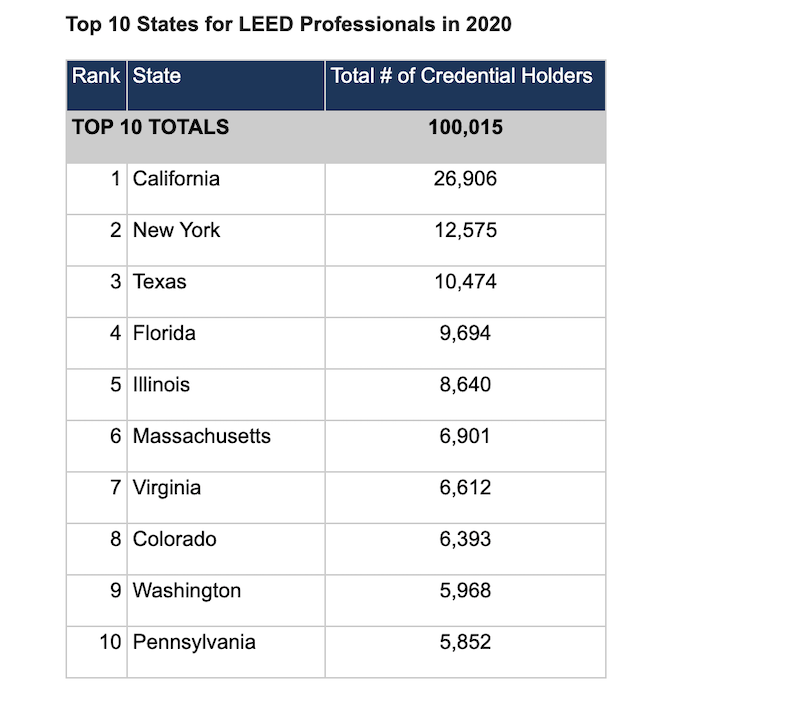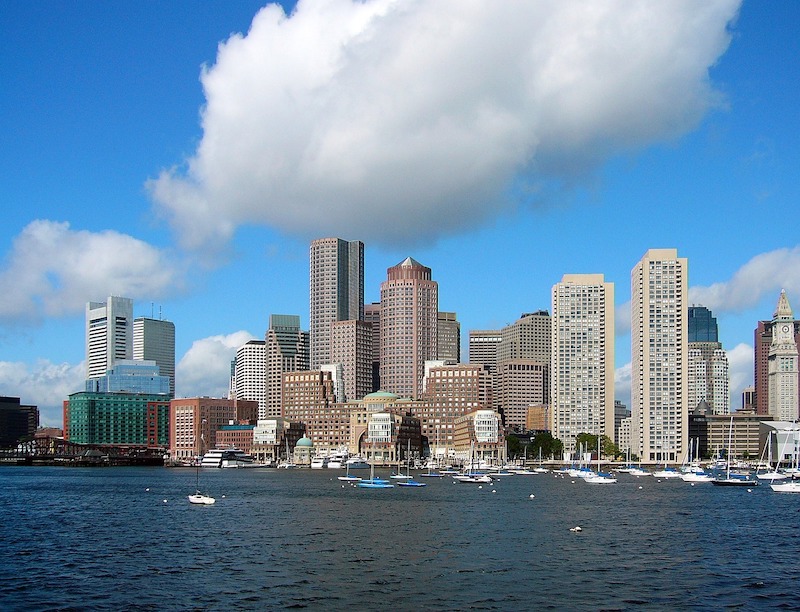The U.S. Green Building Council (USGBC) released its annual list of the Top 10 States for LEED green building with Massachusetts leading the country in 2020 with the most certified square feet per capita. Across the top states, more than 60% of certifications were office, healthcare, higher education and K-12 projects. This year, USGBC also released a ranking of states with the most LEED professionals with California taking the top spot. Collectively, the 2020 rankings represent 1,171 certified LEED buildings and spaces, and more than 100,000 green building workers.
“If we are to rebuild an economy that supports our health and our planet, we must lead with changing the way we design and build,” said Mahesh Ramanujam, president and CEO of USGBC. “Last year was a stark reminder that the quality of our buildings impacts the quality of our life. Looking ahead, people want to trust that the spaces they occupy are good for them and their communities, and LEED has always been a tool to support those goals. Now is the time to ensure that every building is LEED certified as that is the only way we are accomplishing our goals of access to healthy, green buildings, homes and spaces.”
While offices, education and healthcare projects accounted for a majority of certifications, warehouses, distribution centers, multifamily and retail projects represented almost 20%. Also, almost half of all projects were certified Gold, indicating a commitment to a high level of certification.
The Top 10 States for LEED green building is based on gross square feet of certified space per person using 2010 U.S. Census data and includes commercial and institutional projects certified in 2020. The full top 10 state rankings are as follows:

The global green building community is continually improving LEED to ensure it helps buildings, communities and cities to be more sustainable, healthy, resilient and equitable. More than two-thirds of LEED credits support human health, as the rating system addresses ventilation and filtration, daylighting, low-emitting materials, access to outdoor spaces, acoustics and other key factors. In response to the COVID-19 pandemic, USGBC also introduced Safety First guidance to address operational challenges and assist with each state’s re-entry planning.
LEED’s foundation, however, is in its commitment to help the building sector reduce its contribution to climate change. Certification communicates progress in support of climate and ESG commitments and the goal is to get more buildings on a path to certify. Using Arc to track performance, USGBC is tracking nearly 56 million metrics tons of GHG emissions associated with energy and transportation, and more than 167 billion gallons of water. The data show that LEED projects deliver significant reductions in emissions and improvements in occupant experience - and the benefits increase with higher levels of LEED certification. The latest version of the rating system, LEED v4.1, raises the bar on green building performance, defining the latest sustainability standards while enabling project teams to continue to track progress beyond certification.
“If we want to make a positive impact in our communities, we must transform the building sector, and focus on what the data is telling us,” added Ramanujam. “By putting data at the center of LEED we’re helping teams better understand building performance, find ways to improve and ultimately find a path to net zero.”
Since 2018, more than 25 projects globally have certified LEED Zero, which recognizes net zero performance in buildings and spaces. LEED’s third-party certification is the industry’s dominant green building standard and LEED Zero expands on that work verifying achievements in net zero carbon, energy, water and waste. It focuses on a higher level of green building performance.
Transforming the building sector to be more sustainable requires a skilled and knowledgeable workforce. This workforce is contributing to the development and advocacy of LEED and is being quickly embraced by the next generation workforce and decision makers. USGBC has been committed to cultivating and supporting green building professionals through its credentialing and certificate programs. This year, USGBC is also releasing an additional Top 10 list recognizing states with the most LEED green building professionals. The full list is as follows:

More information about LEED certification and green building is available at usgbc.org.
Related Stories
Contractors | Feb 14, 2023
The average U.S. contractor has nine months worth of construction work in the pipeline
Associated Builders and Contractors reports today that its Construction Backlog Indicator declined 0.2 months to 9.0 in January, according to an ABC member survey conducted Jan. 20 to Feb. 3. The reading is 1.0 month higher than in January 2022.
Office Buildings | Feb 9, 2023
Post-Covid Manhattan office market rebound gaining momentum
Office workers in Manhattan continue to return to their workplaces in sufficient numbers for many of their employers to maintain or expand their footprint in the city, according to a survey of more than 140 major Manhattan office employers conducted in January by The Partnership for New York City.
Giants 400 | Feb 9, 2023
New Giants 400 download: Get the complete at-a-glance 2022 Giants 400 rankings in Excel
See how your architecture, engineering, or construction firm stacks up against the nation's AEC Giants. For more than 45 years, the editors of Building Design+Construction have surveyed the largest AEC firms in the U.S./Canada to create the annual Giants 400 report. This year, a record 519 firms participated in the Giants 400 report. The final report includes 137 rankings across 25 building sectors and specialty categories.
Multifamily Housing | Feb 7, 2023
Multifamily housing rents flat in January, developers remain optimistic
Multifamily rents were flat in January 2023 as a strong jobs report indicated that fears of a significant economic recession may be overblown. U.S. asking rents averaged $1,701, unchanged from the prior month, according to the latest Yardi Matrix National Multifamily Report.
Market Data | Feb 6, 2023
Nonresidential construction spending dips 0.5% in December 2022
National nonresidential construction spending decreased by 0.5% in December, according to an Associated Builders and Contractors analysis of data published today by the U.S. Census Bureau. On a seasonally adjusted annualized basis, nonresidential spending totaled $943.5 billion for the month.
Architects | Jan 23, 2023
PSMJ report: The fed’s wrecking ball is hitting the private construction sector
Inflation may be starting to show some signs of cooling, but the Fed isn’t backing down anytime soon and the impact is becoming more noticeable in the architecture, engineering, and construction (A/E/C) space. The overall A/E/C outlook continues a downward trend and this is driven largely by the freefall happening in key private-sector markets.
Hotel Facilities | Jan 23, 2023
U.S. hotel construction pipeline up 14% to close out 2022
At the end of 2022’s fourth quarter, the U.S. construction pipeline was up 14% by projects and 12% by rooms year-over-year, according to Lodging Econometrics.
Products and Materials | Jan 18, 2023
Is inflation easing? Construction input prices drop 2.7% in December 2022
Softwood lumber and steel mill products saw the biggest decline among building construction materials, according to the latest U.S. Bureau of Labor Statistics’ Producer Price Index.
Market Data | Jan 10, 2023
Construction backlogs at highest level since Q2 2019, says ABC
Associated Builders and Contractors reports today that its Construction Backlog Indicator remained unchanged at 9.2 months in December 2022, according to an ABC member survey conducted Dec. 20, 2022, to Jan. 5, 2023. The reading is one month higher than in December 2021.
Market Data | Jan 6, 2023
Nonresidential construction spending rises in November 2022
Spending on nonresidential construction work in the U.S. was up 0.9% in November versus the previous month, and 11.8% versus the previous year, according to the U.S. Census Bureau.

















